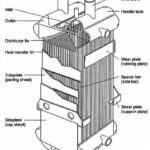Pipe friction head loss calculation
Pipe friction head loss calculation is important for sizing pumps, several equations have been developed to calculate pipe friction head loss, this article will explore the popular methods available.
What is the head loss (pressure drop) due to friction?
When a liquid flow through a pipe, a layer is formed between the pipe wall and the liquid flowing through it. This layer is created as a result of friction between the liquid molecules and the pipe wall. This friction causes energy to be lost and get converted from pressure and kinetic energy to heat. The pressure continuously decreases as water flows down the pipe from the upstream end to the downstream end. The amount of pressure loss due to friction is also known as head loss due to friction. Below are equations commonly used for pipe friction head loss calculation.
Darcy-Weisbach equation
Referred to as Darcy equation in which the pressure drop due to friction in a given length of pipe can be calculated using the Darcy-Weisbach equation as follows:
Equation 1 (US Units)

Where;
H = Fictional pressure loss of liquid height (ft in US units or m in SI units)
fd = Darcy friction factor (dimensionless – usually a number between 0.008 and 0.10)
L = Pipe length (ft in US units or m in SI units)
D= Pipe internal diameter (ft in US units or m in SI units)
V = Average liquid velocity (ft/s in US units or m/s in SI units)
g = Acceleration due to gravity (32.2 ft/s2 in US units or 9.81 m/s2 in SI units)
The equation can be used for gases and liquids flowing through a pipe. With a Velocity head is defined in this equation as (V2 / 2 g)
Equation 2 (US Units)
Another version of Darcy equation using flow rate instead of velocity is shown below:

Where;
Pmi = frictional pressure loss, psi/mile
fd = Darcy friction factor, dimensionless
Q = Flow rate, gal/min
D = Pipe inside diameter, in
Equation 3 (SI Units)
In SI units, the Darcy equation may be written as:

Where;
H = frictional pressure loss, meters of liquid head
fd = Darcy friction factor, dimensionless
L = pipe length, m
D = pipe inside diameter, mm
V = average flow velocity, m/s
Equation 4 (SI Units)

Where;
Pkm = pressure drop due to friction, kPa/km
Q = liquid flow rate, m3/h
fd = Darcy friction factor, dimensionless
D = pipe inside diameter, mm
Calculating the Darcy Friction Factor
Flow Regimes
In order to calculate the Darcy Friction factor flow regimes need to be defined. There are mainly three flow regimes that may be distinguished as follows:
Laminar flow: Reynolds number (Re) < 2000
Critical flow: Reynolds number (Re) > 2000 and Reynolds number (Re) < 4000
Turbulent flow: Reynolds number (Re) > 4000
Colebrook–White equation
Laminar flow
To calculate the Darcy friction factor for laminar flow with Reynolds number Re < 2000,
fd = 64/Re
Where;
fd = Darcy friction factor, dimensionless
Re = Reynolds number, dimensionless
Turbulent flow
To calculate the Darcy friction factor for turbulent flow the Colebrook–White equation below is used:

Where;
fd = Darcy friction factor, dimensionless
D = pipe inside diameter, (US units in inch, millimeter in SI units)
e = absolute pipe roughness, (US units in inch, millimeter in SI units)
Re = Reynolds number, dimensionless
The ratio e/D is known as the relative pipe roughness and is dimensionless
To obtain Darcy friction factor from this equation trial and error is needed until an acceptable value for fd is obtained
The next article discuss the Hazen-Williams equation for using in pipe friction head loss calculation
Useful software
Useful mobile applications











